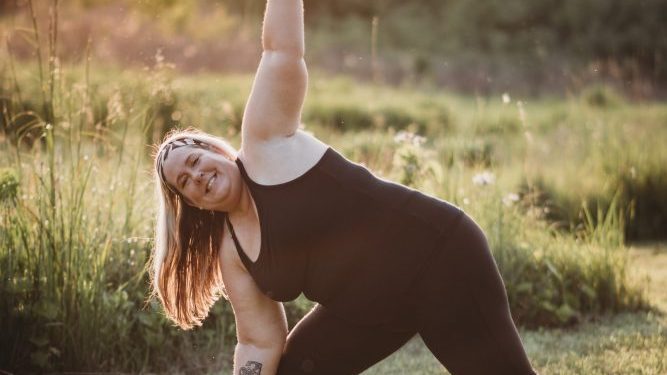by Amy Zellmer, Editor-in-chief
Yoga is a powerful tool for recovery after brain injury. Contrary to some beliefs, EVERYONE can do yoga — you don’t need to be super flexible, have great balance, or even be able to stand up. The beauty of yoga is that every pose can be modified so that anyone can be accommodated.
An important aspect of yoga is the breath. Connecting the breath to your body and flow, and getting oxygen flowing to your brain, is what makes it so powerful for recovery. Yoga is also a time to quiet the mind, letting anxiety and distracting thoughts drift away.
Triangle Pose (Utthita Trikonasana) is a standing pose that allows us an opportunity to focus on stability while we expand. In Sanskrit the word “Utthita” means “extended,” the word “Trikona” means “triangle,” and “Asana” means “pose.” It is a therapeutic post that provides many benefits including reducing anxiety and opening up the chakras.
Some of its many physical benefits include the stretching of legs, muscles around the knee, ankle joints, hips, groin muscles, hamstrings, calves, shoulders, chest, and spine. It also strengthens legs, knees, ankles, abdominals, obliques, and your back and helps stimulate the function of abdominal organs. It also helps relieve stress can improve digestion, and alleviate back pain.
Instructions:
- Start in Warrior II pose with your right foot forward.
- Straighten your front knee and keep a micro-bend in the knee so it does not lock.
- Exhale while sending your left hip toward your back foot, and hinge forward toward the front of your mat.
- Place your right hand on the ground, block, or shin. Reach your left hand toward the sky.
- Gently pull your left ribs back as you encourage your right ribs forward. Both sides should feel equal in length.
- Draw your tailbone down toward your left heel.
- Take your gaze toward your top hand if it feels comfortable on your neck.
- Hold the pose for 30 to 60 seconds. Use an inhalation to bring yourself back up, rooting through the back heel, using it as an anchor.
- Change the position of the feet and repeat on the opposite side.
Adjustments and modifications:
- Place your hand on a block next to your front leg to help keep length in the spine.
- Avoid forcing the hips to be squared.
- Micro-bend your front knee to prevent it from locking.
- Look to the side or down rather than looking up to prevent strain in your neck.
- Practice the pose with your entire body supported against a wall.
If you are interested in learning more about yoga, check out
www.loveyourbrain.com and their yoga programs throughout the U.S. at partner studios, which are completely free to brain injury survivors and caregivers.
Amy Zellmer is an award winning author, keynote speaker, and TBI survivor and advocate. She is Editor-in-chief of The Brain Health Magazine, and hosts the Faces of TBI podcast series, as well as TBI TV on YouTube.











